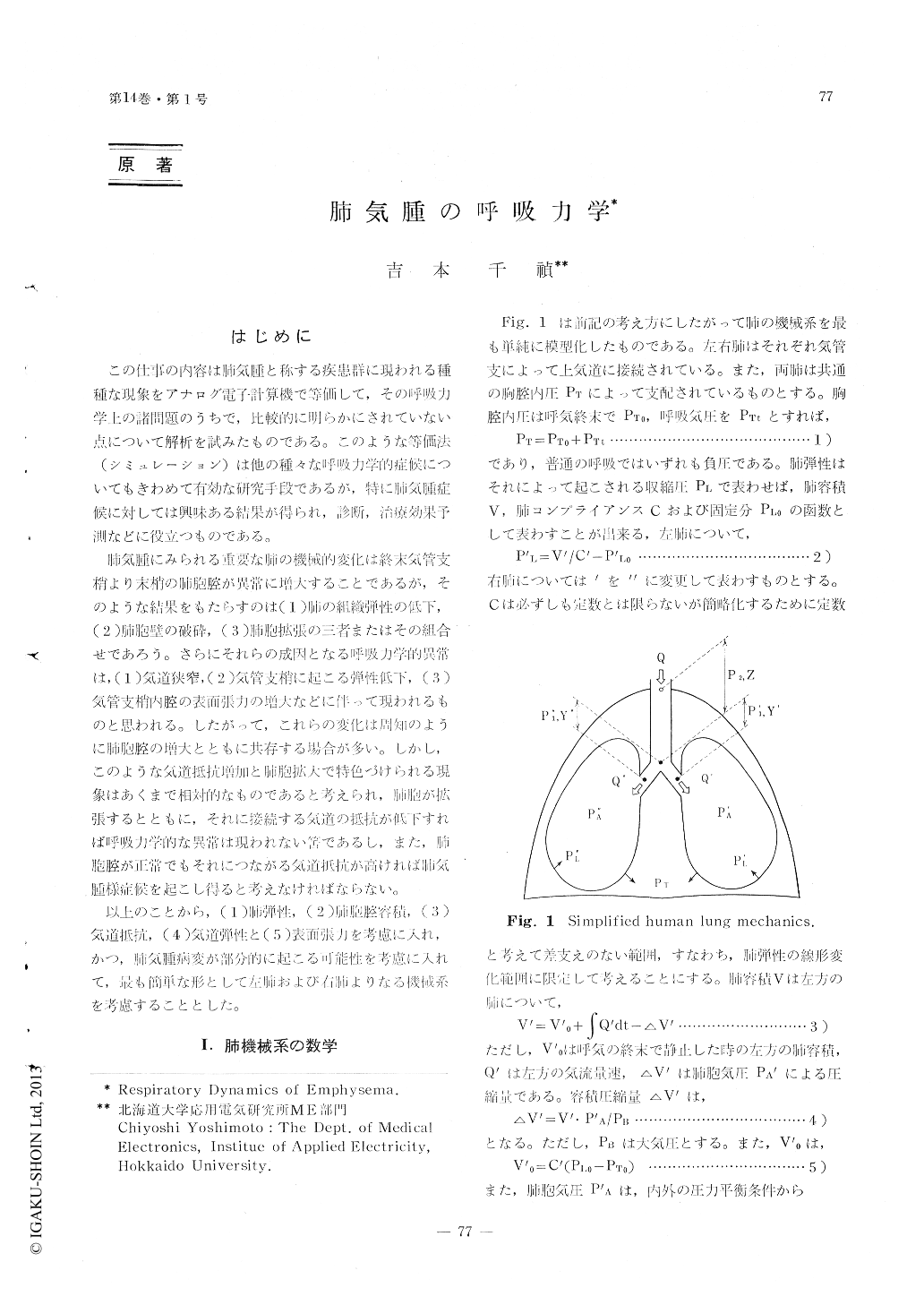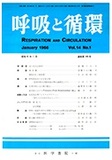Japanese
English
- 有料閲覧
- Abstract 文献概要
- 1ページ目 Look Inside
はじめに
この仕事の内容は肺気腫と称する疾患群に現われる種種な現象をアナログ電子計算機で等価して,その呼吸力学上の諸問題のうちで,比較的に明らかにされていない点について解析を試みたものである。このような等価法(シミュレーション)は他の種々な呼吸力学的症候についてもきわめて有効な研究手段であるが,特に肺気腫症候に対しては興味ある結果が得られ,診断,治療効果予測などに役立つものである。
肺気腫にみられる重要な肺の機械的変化は終末気管支梢より末梢の肺胞腔が異常に増大することであるが,そのような結果をもたらすのは(1)肺の組織弾性の低下,(2)肺胞壁の破砕,(3)肺胞拡張の三者またはその組合せであろう。さらにそれらの成因となる呼吸力学的異常は,(1)気道狭窄,(2)気管支梢に起こる弾性低下,(3)気管支梢内腔の表面張力の増大などに伴って現われるものと思われる。したがって,これらの変化は周知のように肺胞腔の増大とともに共存する場合が多い。しかし,このような気道抵抗増加と肺胞拡大で特色づけられる現象はあくまで相対的なものであると考えられ,肺胞が拡張するとともに,それに接続する気道の抵抗が低下すれば呼吸力学的な異常は現われない筈であるし,また,肺胞腔が正常でもそれにつながる気道抵抗が高ければ肺気腫様症候を起こし得ると考えなければならない。
This study is a trial for the theoretical analysis of relatively complicated phenomena in various respiratory dynamical symptoms of emphysematous diseases by analog com-puter simulation.
The human lung was simplified such that it consists of two alveolar sacks contained in a thoracic cage, each of which is connect-ed to an upper airway through individual bronchus. Following factors were took in account: common thoracic pressure consist-ing of end expiratory and tidal pressures, lung compliances of two lobes which may differ each other, lung elastances in terms of pressure, common upper airway impedance, and bronchiolar airway admittances, each of which is the function of bronchiolar elastance, surface tension of airway wall and pressure difference between thoracic and intrabronchial pressures, an analog simulator was con-structed with 32 amplifiers, 4 function multi-pliers and 27 potentiometers.
Among numerous interesting findings, a few important points were stressed as fol-lows.
1) Dynamic FRC (functional residual capa-city) increases with decreased airway admit-tance while the static FRC remains normal. This increment of dynamic FRC may cause the enlargement of alveolar sacks by the plastic properties of lung tissue, resulting the increase of static FRC and accelerate the enlargement in succession.
2) Check-valve action may be resulted by the increase of airway resistance with normal or increased airway elastance and/or increase of airway surface tention, not necessarily by the collapsing (closing) of airway.
3) In case of uneven obstruction, the con tamination of respiratory gas from one lobe to the other is recognized and, apparently, such contamination may be seen as a part of increased functional dead space.
4) Decrease of airway elastance causes the increase of dynamic FRC and decrease of check -valve action.
5) Increase of lung compliance causes the increase of dynamic FRC Uneveness of lung compliance accelerates contamination of gas.
6) Only the static lung compliance can represent some properties of lung tissue, while so called dynamic compliance is almost meaningless in most obstructive cases.
7) Static compliance may be easily meas-ured by lung volume-thoracic pressure dia-gram with zero-flow signal from flow-meter, without any interruption of breathing.

Copyright © 1966, Igaku-Shoin Ltd. All rights reserved.


